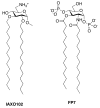TLR4 Signaling Pathway Modulators as Potential Therapeutics in Inflammation and Sepsis
- PMID: 28976923
- PMCID: PMC5748601
- DOI: 10.3390/vaccines5040034
TLR4 Signaling Pathway Modulators as Potential Therapeutics in Inflammation and Sepsis
Abstract
Toll-Like Receptor 4 (TLR4) signal pathway plays an important role in initiating the innate immune response and its activation by bacterial endotoxin is responsible for chronic and acute inflammatory disorders that are becoming more and more frequent in developed countries. Modulation of the TLR4 pathway is a potential strategy to specifically target these pathologies. Among the diseases caused by TLR4 abnormal activation by bacterial endotoxin, sepsis is the most dangerous one because it is a life-threatening acute system inflammatory condition that still lacks specific pharmacological treatment. Here, we review molecules at a preclinical or clinical phase of development, that are active in inhibiting the TLR4-MyD88 and TLR4-TRIF pathways in animal models. These are low-molecular weight compounds of natural and synthetic origin that can be considered leads for drug development. The results of in vivo studies in the sepsis model and the mechanisms of action of drug leads are presented and critically discussed, evidencing the differences in treatment results from rodents to humans.
Keywords: CD14; DAMP; LPS; MD-2; PAMP; TLR4; in vivo studies; sepsis.
Conflict of interest statement
The authors declare no conflict of interest.
Figures








References
-
- Beutler B. TLR4 as the mammalian endotoxin sensor. Curr. Top Microbiol. Immunol. 2002;270:109–120. - PubMed
Publication types
LinkOut - more resources
Full Text Sources
Other Literature Sources
Research Materials

